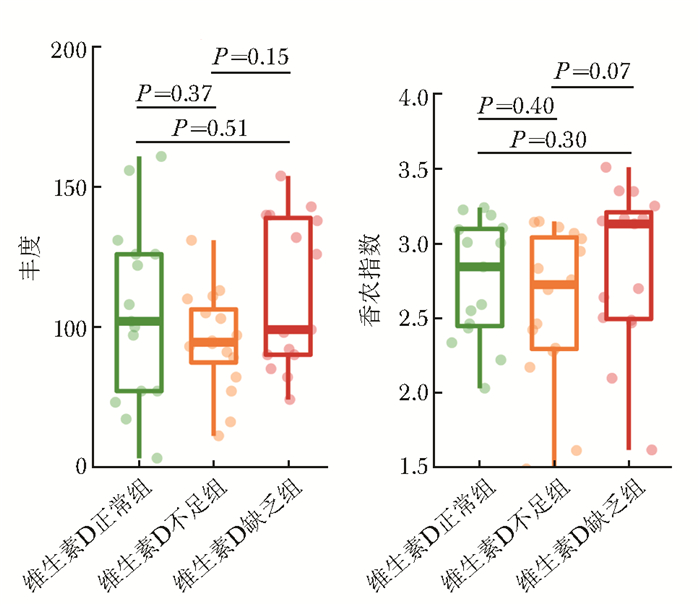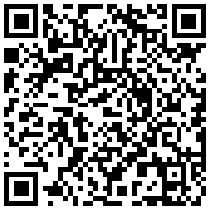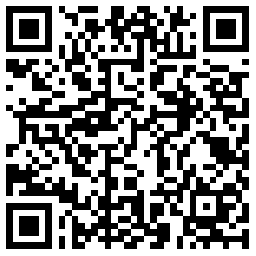Differences of Intestinal Flora in Children with Autism Spectrum Disorder with Different Levels of Serum Total 25-hydroxyvitamin D
-
摘要:
目的 探究孤独症谱系障碍(autism spectrum disorder,ASD)患儿维生素D正常与缺乏状态下的肠道菌群差异及血清总25-羟维生素D[total 25-hydroxyvitamin D,T-25(OH)D]水平与肠道菌群的相关性。 方法 回顾性纳入2019年10月至2022年2月于北京协和医院风湿免疫科门诊就诊的1~12岁ASD患儿的临床资料。采用液相色谱串联质谱法检测ASD患儿的血清T- 25(OH)D水平,并根据血清T- 25(OH)D水平将其分为维生素D正常组[T-25(OH)D>30 μg/L]、不足组[20 μg/L≤T-25(OH)D ≤30 μg/L]和缺乏组[T-25(OH)D<20 μg/L]。应用生物信息学方法分析ASD患儿的肠道宏基因组测序结果。 结果 共46例符合纳入和排除标准的ASD患儿纳入本研究,维生素D正常组、不足组、缺乏组分别为15例、16例、15例。线性判别分析发现,维生素D缺乏组的沃氏嗜胆菌、Adlercreutzia equolifaciens、Asaccharobacter celatus、大肠埃希菌显著升高;而脆弱拟杆菌和Hungatella hathewayi丰度显著降低。沃氏嗜胆菌和Adlercreutzia equolifaciens丰度与血清T- 25(OH)D水平均呈负相关(r=-0.45, fdr=0.055, P=0.002; r=-0.44, fdr=0.055, P=0.003);脆弱拟杆菌丰度与血清T- 25(OH)D水平呈正相关(r=0.42, fdr=0.073, P=0.004)。 结论 ASD患儿的维生素D缺乏状态可能加重肠道菌群紊乱,血清T-25(OH)水平降低可能使潜在有害菌定植增加、益生菌定植减少。本研究为ASD患儿积极补充维生素D提供了证据支持。 Abstract:Objective To investigate the differences of intestinal flora in Vitamin D adequacy and deficiency groups of children with autism spectrum disorder(ASD) and the correlation between serum total 25-hydroxyvitamin D [T-25(OH)D] levels and intestinal flora. Methods ASD children who attended the outpatient clinic of the department of Rheumatology and Clinical Immunology of Peking Union Medical College Hospital during October 2009 and February 2022 were retrospectively included in the study. According to the serum T-25(OH)D levels, they were divided into Vitamin D adequacy group[T-25(OH)D > 30 μg/L], Vitamin D insufficiency group[20 μg/L≤T-25(OH)D≤30 μg/L] and Vitamin D deficiency group[T-25(OH)D < 20 μg/L].Serum T-25(OH)D levels were measured using liquid chromatography-tandem mass spectrometry. Human gut metagenome data from these children with ASD were analyzed using bioinformatics methods. Results 46 children with ASD who met the inclusion and exclusion criteria were included in the study. The numbers of patients in Vitamin D adequacy group, Vitamin D insufficiency group and Vitamin D deficiency group were respectively 15, 16 and 15. Linear discriminant analysis revealed that the bacteria abundance of Bilophila wadsworthia, Adlercreutzia equolifaciens, Asaccharobacter celatus and Escherichia coli were significantly enriched, while the bacteria abundance of Bacteroides fragilis and Hungatella hathewayi were significantly lower in the Vitamin D deficiency group. The relative abundance of Bilophila wadsworthia and Adlercreutzia equolifaciens were negatively correlated with serum T-25(OH)D levels(r=-0.45, fdr=0.055, P=0.002;r=-0.44, fdr=0.055, P=0.003), and the relative abundance of Bacteroides fragilis was positively correlated with serum T-25(OH)D levels (r=0.42, fdr=0.073, P=0.004). Conclusions Vitamin D deficiency in ASD may exacerbate ASD flora disorders, and decreased serum T-25(OH)D levels may facilitate potentially harmful bacteria but inhibit probiotic colonization. This study provides partial evidence that children with ASD should be actively supplemented with vitamin D. -
Key words:
- gut microbiota /
- autism spectrum disorder /
- vitamin D
作者贡献:罗欣负责数据处理和论文撰写;庞琨、陈建雄、王泓哲负责数据处理;徐新杰、李兵负责研究指导;贾鑫淼和尤欣负责研究设计、论文修订与审核。利益冲突:所有作者均声明不存在利益冲突 -
表 1 ASD患儿一般临床资料
组别 男性[n(%)] 年龄(x±s,岁) CARS评分(x±s) 重度ASD[n(%)] 维生素D正常组(n=15) 12(80.0) 3.20±1.859 39.00±5.928 10(66.7) 维生素D不足组(n=16) 11(68.8) 3.44±1.459 41.69±6.681 12(75.0) 维生素D缺乏组(n=15) 11(73.3) 4.40±1.056 39.67±6.619 10(66.7) 组别 胃肠道症状[n(%)] 挑食[n(%)] 兴奋[n(%)] 过敏[n(%)] 情绪问题[n(%)] 维生素D正常组(n=15) 15(100) 12(80.0) 15(100) 14(93.3) 12(80.0) 维生素D不足组(n=16) 15(93.8) 15(93.8) 16(100) 12(75.0) 14(87.5) 维生素D缺乏组(n=15) 15(100) 13(86.7) 15(100) 12(80.0) 13(86.7) ASD: 孤独症谱系障碍;CARS:儿童孤独症评定量表 表 2 孤独症谱系障碍患儿肠道菌群β多样性分析
分组 置换多元方差分析 R2 P 维生素D缺乏组比正常组 0.0387 0.291 维生素D不足组比正常组 0.0266 0.541 维生素D不足组比缺乏组 0.0316 0.382 -
[1] 中华医学会儿科学分会发育行为学组, 中国医师协会儿科分会儿童保健专业委员会, 儿童孤独症诊断与防治技术和标准研究项目专家组. 孤独症谱系障碍儿童早期识别筛查和早期干预专家共识[J]. 中华儿科杂志, 2017, 55: 890-897. doi: 10.3760/cma.j.issn.0578-1310.2017.12.004 [2] 中华医学会儿科学分会发育行为学组, 中国医师协会儿科分会儿童保健专业委员会, 儿童孤独症诊断与防治技术和标准研究项目专家组. 孤独症谱系障碍患儿常见共患问题的识别与处理原则[J]. 中华儿科杂志, 2018, 56: 174-178. doi: 10.3760/cma.j.issn.0578-1310.2018.03.004 [3] Saurman V, Margolis KG, Luna RA. Autism Spectrum Disorder as a Brain-Gut-Microbiome Axis Disorder[J]. Dig Dis Sci, 2020, 65: 818-828. doi: 10.1007/s10620-020-06133-5 [4] Cryan JF, O'riordan KJ, Cowan CSM, et al. The Microbiota-Gut-Brain Axis[J]. Physiol Rev, 2019, 99: 1877-2013. doi: 10.1152/physrev.00018.2018 [5] Li N, Chen H, Cheng Y, et al. Fecal Microbiota Transplantation Relieves Gastrointestinal and Autism Symptoms by Improving the Gut Microbiota in an Open-Label Study[J]. Front Cell Infect Microbiol, 2021, 11: 759435. doi: 10.3389/fcimb.2021.759435 [6] Murdaca G, Gerosa A, Paladin F, et al. Vitamin D and Microbiota: Is There a Link with Allergies?[J]. Int J Mol Sci, 2021, 22: 4288. doi: 10.3390/ijms22084288 [7] Malaguarnera L. Vitamin D and microbiota: Two sides of the same coin in the immunomodulatory aspects[J]. Int Immunopharmacol, 2020, 79: 106112. doi: 10.1016/j.intimp.2019.106112 [8] Wong M. What has happened in the last 50 years in immunology[J]. J Paediatr Child Health, 2015, 51: 135-139. doi: 10.1111/jpc.12834 [9] Bellerba F, Muzio V, Gnagnarella P, et al. The Associa-tion between Vitamin D and Gut Microbiota: A Systematic Review of Human Studies[J]. Nutrients, 2021, 13: 3378. doi: 10.3390/nu13103378 [10] Feng J, Shan L, Du L, et al. Clinical improvement following vitamin D3 supplementation in autism spectrum disorder[J]. Nutr Neurosci, 2017, 20: 284-290. doi: 10.1080/1028415X.2015.1123847 [11] American Psychiatric Association. Diagnostic and statistical manual of mental disorders: DSM-5[M]. 5th ed. Washington DC: American Psychiatric Association, 2013: 50-59. [12] Holick MF, Binkley NC, Bischoff-Ferrari HA, et al. Evaluation, treatment, and prevention of vitamin D deficiency: an Endocrine Society clinical practice guideline[J]. J Clin Endocrinol Metab, 2011, 96: 1911-1930. doi: 10.1210/jc.2011-0385 [13] Society for Adolescent Health and Medicine. Recommended vitamin D intake and management of low vitamin D status in adolescents: a position statement of the society for adolescent health and medicine[J]. J Adolesc Health, 2013, 52: 801-803. doi: 10.1016/j.jadohealth.2013.03.022 [14] Yu S, Zhang R, Zhou W, et al. Is it necessary for all samples to quantify 25OHD2 and 25OHD3 using LC-MS/MS in clinical practice?[J]. Clin Chem Lab Med, 2018, 56: 273-277. doi: 10.1515/cclm-2017-0520 [15] Krueger F. Trim Galore, V. 0.6.2[EB/OL]. (2019-05-08)[2022-05-10]. http://www.bioinformatics.babraham.ac.uk/projects/trim_galore/. [16] Langmead B, Salzberg SL. Fast gapped-read alignment with Bowtie 2[J]. Nat Methods, 2012, 9: 357-359. doi: 10.1038/nmeth.1923 [17] Danecek P, Bonfield JK, Liddle J, et al. Twelve years of SAMtools and BCFtools[J]. Gigascience, 2021, 10: giab008. doi: 10.1093/gigascience/giab008 [18] Quinlan AR. BEDTools: the Swiss-army tool for genome feature analysis[J]. Curr Protoc Bioinform, 2014, 47: 11.12.1-11.12.34. [19] Casper J, Zweig AS, Villarreal C, et al. The UCSC genome browser database: 2018 update[J]. Nucleic Acids Res, 2018, 46: D762-D769. doi: 10.1093/nar/gkx1020 [20] Beghini F, Mciver LJ, Blanco-Míguez A, et al. Integrat-ing taxonomic, functional, and strain-level profiling of diverse microbial communities with bioBakery 3[J]. Elife, 2021, 10: e65088. doi: 10.7554/eLife.65088 [21] Segata N, Izard J, Waldron L, et al. Metagenomic biomarker discovery and explanation[J]. Genome Biol, 2011, 12: R60. doi: 10.1186/gb-2011-12-6-r60 [22] Singh P, Kumar M, Al Khodor S. Vitamin D Deficiency in the Gulf Cooperation Council: Exploring the Triad of Genetic Predisposition, the Gut Microbiome and the Immune System[J]. Front Immunol, 2019, 10: 1042. doi: 10.3389/fimmu.2019.01042 [23] Yamamoto E, Jørgensen TN. Immunological effects of vitamin D and their relations to autoimmunity[J]. J Autoimmun, 2019, 100: 7-16. doi: 10.1016/j.jaut.2019.03.002 [24] Yamamoto EA, Jørgensen TN. Relationships between vitamin D, gut microbiome, and systemic autoimmunity[J]. Front Immunol, 2020, 10: 3141. doi: 10.3389/fimmu.2019.03141 [25] Reboul E. Intestinal absorption of vitamin D: from the meal to the enterocyte[J]. Food Funct, 2015, 6: 356-362. doi: 10.1039/C4FO00579A [26] Bora SA, Kennett MJ, Smith PB, et al. The Gut Microbiota Regulates Endocrine Vitamin D Metabolism through Fibroblast Growth Factor 23[J]. Front Immunol, 2018, 9: 408. doi: 10.3389/fimmu.2018.00408 [27] Leeming ER, Johnson AJ, Spector TD, et al. Effect of Diet on the Gut Microbiota: Rethinking Intervention Duration[J]. Nutrients, 2019, 11: 2862. doi: 10.3390/nu11122862 [28] Saad K, Abdel-Rahman AA, Elserogy YM, et al. Vitamin D status in autism spectrum disorders and the efficacy of vitamin D supplementation in autistic children[J]. Nutr Neurosci, 2016, 19: 346-351. doi: 10.1179/1476830515Y.0000000019 [29] Mazahery H, Conlon CA, Beck KL, et al. A randomised controlled trial of vitamin D and omega-3 long chain polyunsaturated fatty acids in the treatment of irritability and hyperactivity among children with autism spectrum disorder[J]. J Steroid Biochem Mol Biol, 2019, 187: 9-16. doi: 10.1016/j.jsbmb.2018.10.017 [30] Caplan A, Walker L, Rasquin A. Development and Preliminary Validation of the Questionnaire on Pediatric Gastrointestinal Symptoms to Assess Functional Gastrointestinal Disorders in Children and Adolescents[J]. J Pediatr Gastroenterol Nutr, 2005, 41: 296-304. doi: 10.1097/01.mpg.0000172748.64103.33 [31] Munk DD, Repp AC. Behavioral assessment of feeding problems of individuals with severe disabilities[J]. J Appl Behav Anal, 1994, 27: 241-250. doi: 10.1901/jaba.1994.27-241 [32] Waite DW, Chuvochina M, Pelikan C, et al. Proposal to reclassify the proteobacterial classes Deltaproteobacteria and Oligoflexia, and the phylum Thermodesulfobacteria into four phyla reflecting major functional capabilities[J]. Int J Syst Evol Microbiol, 2020, 70: 5972-6016. doi: 10.1099/ijsem.0.004213 [33] Pulikkan J, Maji A, Dhakan DB, et al. Gut microbial dysbiosis in Indian children with autism spectrum disorders[J]. Microb Ecol, 2018, 76: 1102-1114. doi: 10.1007/s00248-018-1176-2 [34] Tomova A, Husarova V, Lakatosova S, et al. Gastrointestinal microbiota in children with autism in Slovakia[J]. Physiol Behav, 2015, 138: 179-187. doi: 10.1016/j.physbeh.2014.10.033 [35] Liu S, Li E, Sun Z, et al. Altered gut microbiota and short chain fatty acids in Chinese children with autism spectrum disorder[J]. Sci Rep, 2019, 9: 287. doi: 10.1038/s41598-018-36430-z [36] Mitsui R, Ono S, Karaki S, et al. Neural and non-neural mediation of propionate-induced contractile responses in the rat distal colon[J]. Neurogastroenterol Motil, 2005, 17: 585-594. doi: 10.1111/j.1365-2982.2005.00669.x [37] Murros KE. Hydrogen Sulfide Produced by Gut Bacteria May Induce Parkinson's Disease[J]. Cells, 2022, 11: 978. doi: 10.3390/cells11060978 [38] Feng Z, Long W, Hao B, et al. A human stool-derived Bilophila wadsworthia strain caused systemic inflammation in specific-pathogen-free mice[J]. Gut Pathogens, 2017, 9: 59. doi: 10.1186/s13099-017-0208-7 [39] Laue HE, Korrick SA, Baker ER, et al. Prospective associations of the infant gut microbiome and microbial function with social behaviors related to autism at age 3 years[J]. Sci Rep, 2020, 10: 15515. doi: 10.1038/s41598-020-72386-9 [40] Rosenfeld CS. Effects of phytoestrogens on the developing brain, gut microbiota, and risk for neurobehavioral disorders[J]. Front Nutr, 2019, 6: 142. doi: 10.3389/fnut.2019.00142 [41] Gilad LA, Tirosh O, Schwartz B. Phytoestrogens regulate transcription and translation of vitamin D receptor in colon cancer cells[J]. J Endocrinol, 2006, 191: 387-398. doi: 10.1677/joe.1.06930 [42] Assa A, Vong L, Pinnell LJ, et al. Vitamin D Deficiency Predisposes to Adherent-invasive Escherichia coli-induced Barrier Dysfunction and Experimental Colonic Injury[J]. Inflamm Bowel Dis, 2015, 21: 297-306. doi: 10.1097/MIB.0000000000000282 [43] Zou R, Xu F, Wang Y, et al. Changes in the gut microbiota of children with autism spectrum disorder[J]. Autism Res, 2020, 13: 1614-1625. doi: 10.1002/aur.2358 [44] Hsiao EY, Mcbride SW, Hsien S, et al. Microbiota modulate behavioral and physiological abnormalities associated with neurodevelopmental disorders[J]. Cell, 2013, 155: 1451-1463. doi: 10.1016/j.cell.2013.11.024 [45] Sun J. Dietary vitamin D, vitamin D receptor, and microbiome[J]. Curr Opin Clin Nutr Metab Care, 2018, 21: 471-474. doi: 10.1097/MCO.0000000000000516 [46] Kaur S, Yawar M, Kumar PA, et al. Hungatella effluvii gen. nov., sp. nov., an obligately anaerobic bacterium isolated from an effluent treatment plant, and reclassification of Clostridium hathewayi as Hungatella hathewayi gen. nov., comb. nov[J]. Int J Syst Evol Microbiol, 2014, 64: 710-718. doi: 10.1099/ijs.0.056986-0 [47] Ohara T. Identification of the microbial diversity after fecal microbiota transplantation therapy for chronic intractable constipation using 16s rRNA amplicon sequencing[J]. PLoS One, 2019, 14: e0214085. doi: 10.1371/journal.pone.0214085 [48] Chan CWH, Leung TF, Choi KC, et al. Association of early-life gut microbiome and lifestyle factors in the development of eczema in Hong Kong infants[J]. Exp Dermatol, 2021, 30: 859-864. doi: 10.1111/exd.14280 [49] Ooi JH, Li Y, Rogers CJ, et al. Vitamin D regulates the gut microbiome and protects mice from dextran sodium sulfate-induced colitis[J]. J Nutr, 2013, 143: 1679-1686. doi: 10.3945/jn.113.180794 -


 作者投稿
作者投稿 专家审稿
专家审稿 编辑办公
编辑办公 邮件订阅
邮件订阅 RSS
RSS


 下载:
下载:

















